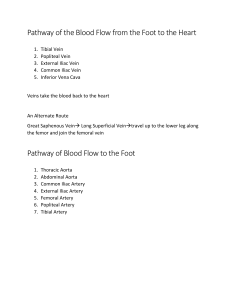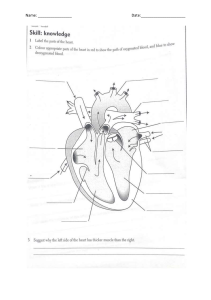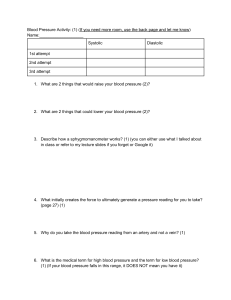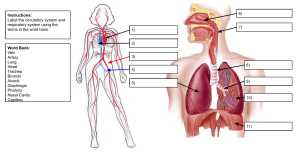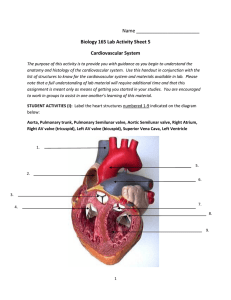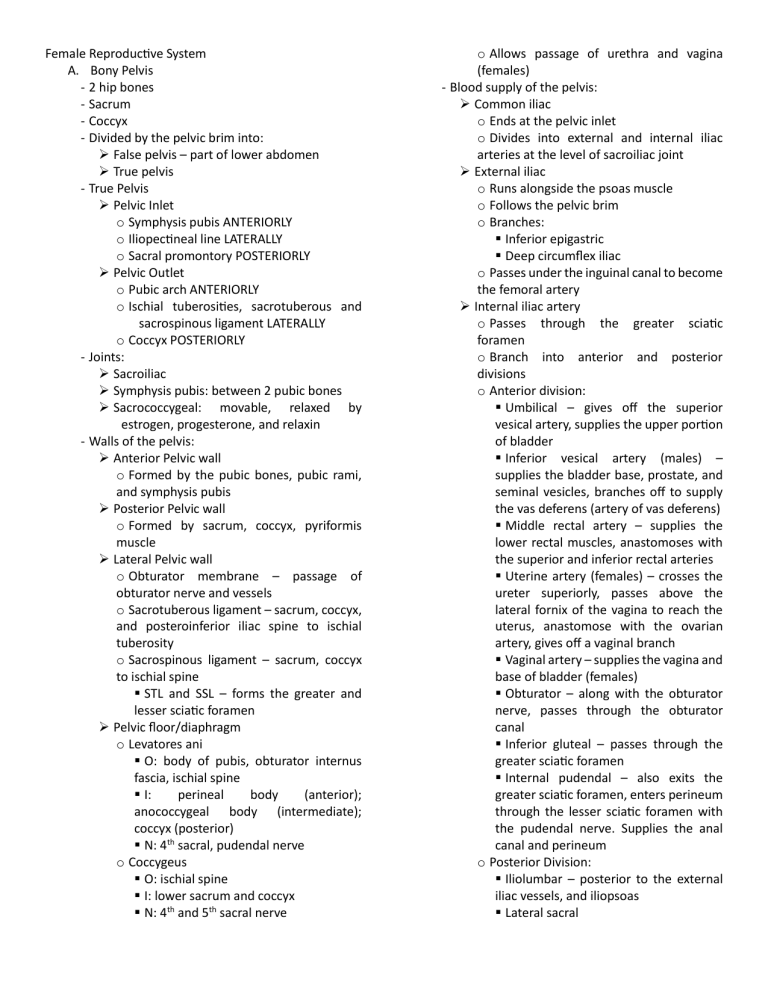
Female Reproductive System A. Bony Pelvis - 2 hip bones - Sacrum - Coccyx - Divided by the pelvic brim into: ➢ False pelvis – part of lower abdomen ➢ True pelvis - True Pelvis ➢ Pelvic Inlet o Symphysis pubis ANTERIORLY o Iliopectineal line LATERALLY o Sacral promontory POSTERIORLY ➢ Pelvic Outlet o Pubic arch ANTERIORLY o Ischial tuberosities, sacrotuberous and sacrospinous ligament LATERALLY o Coccyx POSTERIORLY - Joints: ➢ Sacroiliac ➢ Symphysis pubis: between 2 pubic bones ➢ Sacrococcygeal: movable, relaxed by estrogen, progesterone, and relaxin - Walls of the pelvis: ➢ Anterior Pelvic wall o Formed by the pubic bones, pubic rami, and symphysis pubis ➢ Posterior Pelvic wall o Formed by sacrum, coccyx, pyriformis muscle ➢ Lateral Pelvic wall o Obturator membrane – passage of obturator nerve and vessels o Sacrotuberous ligament – sacrum, coccyx, and posteroinferior iliac spine to ischial tuberosity o Sacrospinous ligament – sacrum, coccyx to ischial spine ▪ STL and SSL – forms the greater and lesser sciatic foramen ➢ Pelvic floor/diaphragm o Levatores ani ▪ O: body of pubis, obturator internus fascia, ischial spine ▪ I: perineal body (anterior); anococcygeal body (intermediate); coccyx (posterior) ▪ N: 4th sacral, pudendal nerve o Coccygeus ▪ O: ischial spine ▪ I: lower sacrum and coccyx ▪ N: 4th and 5th sacral nerve o Allows passage of urethra and vagina (females) - Blood supply of the pelvis: ➢ Common iliac o Ends at the pelvic inlet o Divides into external and internal iliac arteries at the level of sacroiliac joint ➢ External iliac o Runs alongside the psoas muscle o Follows the pelvic brim o Branches: ▪ Inferior epigastric ▪ Deep circumflex iliac o Passes under the inguinal canal to become the femoral artery ➢ Internal iliac artery o Passes through the greater sciatic foramen o Branch into anterior and posterior divisions o Anterior division: ▪ Umbilical – gives off the superior vesical artery, supplies the upper portion of bladder ▪ Inferior vesical artery (males) – supplies the bladder base, prostate, and seminal vesicles, branches off to supply the vas deferens (artery of vas deferens) ▪ Middle rectal artery – supplies the lower rectal muscles, anastomoses with the superior and inferior rectal arteries ▪ Uterine artery (females) – crosses the ureter superiorly, passes above the lateral fornix of the vagina to reach the uterus, anastomose with the ovarian artery, gives off a vaginal branch ▪ Vaginal artery – supplies the vagina and base of bladder (females) ▪ Obturator – along with the obturator nerve, passes through the obturator canal ▪ Inferior gluteal – passes through the greater sciatic foramen ▪ Internal pudendal – also exits the greater sciatic foramen, enters perineum through the lesser sciatic foramen with the pudendal nerve. Supplies the anal canal and perineum o Posterior Division: ▪ Iliolumbar – posterior to the external iliac vessels, and iliopsoas ▪ Lateral sacral ▪ Superior gluteal – supplies the perineum ➢ Ovarian Artery o From abdominal aorta (L1 vertebra) o Enters the suspensory ligament of the ovary and the ovary via the mesovarium o Crosses the external iliac artery via the pelvic inlet ➢ Superior rectal artery o Direct continuation of IMA (abdomen) o Rectum and upper half of anal canal ➢ Median sacral artery ➢ Arteries of the True Pelvis: o Internal iliac o Superior rectal o Ovarian o Median sacral - Venous drainage of the pelvis: ➢ External iliac vein o Continuation of femoral vein o Forms the common iliac vein with the internal iliac vein o Receives inferior epigastric and deep circumflex iliac veins ➢ Internal iliac vein o Forms the common iliac vein with the external iliac vein ➢ Superior rectal vein o Drains the upper part of rectum and anal canal o Forms the inferior mesenteric vein as it crosses the internal iliac vein ➢ Ovarian vein (female) o RIGHT: to the inferior vena cava o LEFT: to left renal vein ➢ Median sacral o Drains to either inferior vena cava or the left common iliac vein - Nerve Supply of the pelvis ➢ Sacral plexus o Branches @ the greater sciatic foramen ▪ Sciatic nerve – LARGEST NERVE OF THE BODY (L4,L5, S1-3) ▪ Superior gluteal – gluteus medius and minimus + tensor fascia latae ▪ Inferior gluteal – gluteus maximus ▪ Nerve to quadratus – gemellus inferior + quadratus femoris ▪ Nerve to obturator – gemellus superior + obturator internus ▪ Posterior cutaneous nerve of thigh o Branches to pelvis and perineum: ▪ Pudendal nerve (S2,3,4) – enters the lesser sciatic foramen ▪ Nerve to piriformis ▪ Pelvic splanchnic nerve o Perforating cutaneous nerve – supplies the skin of ass - Shapes of the pelvis/ Caldwell-Moloy classification: ➢ Gynecoid o Most common and most suitable for normal delivery o Bilog ➢ Platypelloid o Oblong ➢ Anthropoid o Mais ➢ Android o Heart (nonanatomical) PERINEUM - Below the pelvic diaphragm - Diamond shaped - Boundaries: ➢ Symphysis pubis ANTERIORLY ➢ Tip of coccyx POSTERIORLY ➢ Ischial tuberosities LATERALLY - Perineal Triangles ➢ Anterior – urogenital triangle ➢ Posterior – anal triangle - Urogenital diaphragm ➢ Fills the gap of the pubic arch ➢ Sphincter urethrae and deep transverse perineal fascia - Perineal body ➢ Attached to the posterior margin of the urogenital diaphragm, attachment site for anterior fibers of levator ani muscle - Perineal Pouches ➢ Superficial perineal pouch o Potential space beneath the perineal skin (site for hematoma) o Boundaries: ▪ Colle’s fascia INFERIORLY ▪ Urogenital fascia SUPERIORLY ▪ Colle’s fascia to urogenital diaphragm POSTERIORLY AND LATERALLY ➢ Deep perineal pouch o Beneath the urogenital diaphragm o Structures (female) ▪ Urethra ▪ Vagina ▪ Sphincter urethrae ▪ Deep transverse urogenital fascia ▪ Internal pudendal art, vein, and nerve ▪ Dorsal nerve of clit FEMALE EXTERNAL GENITALIA - Mons pubis ➢ Hairy part ➢ Escutcheon, triangular in females, diamond in males ➢ Anterior and superior to symphysis pubis - Labia Majora ➢ Yung nasa labas ➢ Homologous to scrotum ➢ Bilat - Labia Minora ➢ Nymphae ➢ Inside the labia majora ➢ Forms the fourchette POSTERIORLY ➢ Prepuce SUPERIORLY ➢ Frenulum INFERIORLY ➢ Homologous to penile urethra and skin of penis ➢ Yung tahong - Hymen ➢ Yung napupunit ➢ Entrance of vagina ➢ Stratified squamous - Clitoris ➢ Homologous to penis ➢ Erectile organ with 2 crura attached at symphysis pubis, body with corpora cavernosa and erectile tissue - Three masses of Erectile Tissue: ➢ Bulb of vestibule o Homologous to bulb of penis o Divided by the vagina o Beneath the urogenital diaphragm covered by bulbospongiosus muscle o Forms the clitoris as it unites anteriorly ➢ Right and left crura of the clitoris o Corresponds to penile crura o Covered by ischiocavernous muscle - Vestibule ➢ Space between the labia minora ➢ Clitoris at the apex ➢ Urethral opening, vagina and vestibular gland opening at floor - Greater Vestibular Gland ➢ Mucus-secreting gland ➢ Open into the groove between the hymen - Female Urethra ➢ Below the clitoris in front of the vagina - Muscles of the female urogenital triangle: ➢ Superficial transverse perineal o O: ischial tuberosity o I: perineal body o N: pudendal nerve, perineal branch o A: fixes the perineum ➢ Bulbospongiosus o O: pineal body o I: corpus cavernosum fascia o N: puedendal nerve, perineal branch o A: sphincter of vagina, assist in clitoris erection ➢ Ischiocavernosus o O: ischial tuberosity o I: same as bulbospongiosus o N: same o A: clitoris erection ➢ Deep transverse muscle o O: ramus if ischium o I: perineal body o N: same o A: same as superficial transverse ➢ Sphincter urethrae o O: pubic arch o I: surrounding the urethra o N: same o A: voluntary sphincter of urethra FEMALE INTERNAL GENITALIA - Ovaries ➢ Paired, light gray structure on the ovarian fossa at the lateral wall of pelvis ➢ Attached to the broad ligament by the mesovarium ➢ Cortex: where ovarian follicles are ➢ Medulla: nerve and blood vessels ➢ Ligaments of the ovaries: o Suspensory ligament / infundibulopelvic ligament ▪ Connects mesovarium to lateral pelvis ▪ Contains blood and lymph vessels and nerves supplying the ovary o Round ligament of ovary ▪ Part of upper gubernaculum ▪ From medial margin of ovary to lateral wall of uterus o Round ligament of uterus ▪ Remnant of lower gubernaculum o Mesovarium ▪ Posterior part of broad ligament ▪ Contains the anastomotic branches of ovarian and uterine artery, venous plexuses, and lateral end of ovarian artery ➢ Blood supply: o Ovarian artery (from abdominal aorta) o Ovarian vein ▪ Right: to inferior vena cava ▪ Left: to left renal vein ➢ Nerve supply: o Aortic Plexus ➢ Lymphatic drainage: o Para-aortic nodes at level of L1 - Uterus ➢ Fundus: above the uterine tube ➢ Body: beneath the uterine tube ➢ Cervical canal: to cervix o Internal os: communicates with the uteris o External os: communicates with the vagina ➢ Anterversion: forward bending of uterus on the long axis of vagina ➢ Anteflexion: forward bending of the uterus on the cervix ➢ Retroversion: backward bending on long axis ➢ Retroflexion: backward bending on cervix ➢ Layers of the uterus: o Serosal layer ▪ External layer ▪ Covered by visceral peritoneum except anteriorly at the level of internal os (pouch of Douglas) o Muscular layer ▪ Outer and inner longitudinal ▪ Middle interlacing o Endometrium ▪ Mucous membrane with tubular glands ▪ Tall columnar epithelium ▪ Inner: stratum basale ▪ Outer: stratum functionale; regenerative layer, degenerates every menstrual cycle - Uterine/fallopian tubes/oviducts ➢ Mucosal cells of oviducts: o Ciliated epithelium ▪ Columnar cells ▪ At the ovarian end of oviduct ▪ 25% of mucosal cells o Secretory cells ▪ Columnar cells ▪ At the isthmus ▪ 60% of cells o Peg cells ▪ Narrow cells between secretory and ciliated cells ➢ Part of the oviduct o Infundibulum ▪ Funnel shaped ▪ Lateral end ▪ Contains fimbriae that sweeps the ovum into the tube o Ampulla ▪ Widest part ▪ Where fertilization occurs o Isthmus ▪ Narrowest part ▪ Highly developed musculature ▪ Lateral to uterus / medial part of oviduct o Intramural/interstitial part ▪ Most medial portion ▪ Pierces the uterus ▪ Surrounded by myometrium ➢ Blood supply: o Terminal branches of ovarian and uterine artery ➢ Lymphatic drainage o Internal iliac and para-aortic nodes ➢ Nerve supply: o Superior and inferior hypogastric plexuses (sympa and parasympa) - Cervix/trachelos/neck ➢ Lower part of uterus where vagina is attached obliquely in the middle o Divides the cervix into: ▪ Upper ▪ Supravaginal – covered by peritoneum posteriorly, anteriorly by parametrium ▪ Lower/portio vaginalis ➢ Cervical canal epithelium: o Endocervical canal – single layer of columnar epithelium, secretes mucus o Portio vaginalis – stratified squamous, nonkeratinized o Exocervix – stratified squamous, site for pap smear o Squamocolumnar junction ▪ Abrupt transition from tall columnar to stratified squamous between endocervix and portio vaginalis ➢ Blood supply: o Descending branch of uterine artery o Coronary artery – encircles the cervix o Azygos artery – longitudinally at the middle of the anterior and posterior cervix and vagina ▪ Severe postpartum bleeding ▪ 3 and 9 o’clock of the cervix ➢ Lymphatic drainage: o Obturator o Common iliac o Internal iliac o External iliac o Visceral nodes of parametria ➢ Nerve supply o S2 to S4 - Vagina ➢ Female genital canal ➢ 0.08 cm decrease in length every 10 years o 0.17 cm decrease in menopause ➢ Upper half of vagina: o Bladder ANTERIORLY o Rectum POSTERIORLY o Within the PELVIS ➢ Lower half: o Within the PERINEUM o Urethra ANTERIORLY o Anal canal POSTERIORLY ➢ Upper(most) portion: o Almost horizontal plane when standing o 90 degrees between the vagina and axis of uterus o Curves towed the hollos of sacrum ➢ Layers of the vagina (histologic) o Mucosa – stratified squamous nonkeratinized o Lamina propia – fibrous connective tissue, tunica layer o Muscular layer – interlacing muscle fibers (same as intermediate myometrium) o Cellular areolar connective tissue – contains blood vessels ➢ Supporting structures: o Upper third: ▪ Levator ani ▪ Transcervical ligament ▪ Pubocervical ligament ▪ Sacrocervical ligament o Middle third: ▪ Urogenital diaphragm ▪ Cardinal ligaments (lower) ▪ Lower levator ani o Lower third: ▪ Perineal body ➢ Blood supply: o Vaginal artery – from internal iliac artery o Vaginal branch of uterine artery o Azygos artery – branches of interna pudendal, inferior vesical, and middle hemorrhoidal artery ➢ Venous drainage: o Pudendal veins – drains below the pelvic floor o Vaginal, uterine, vesical veins – upper and middle vagina o Vaginal veins drain to the internal iliac vein ➢ Nerve supply: o Autonomic nerves from the vaginal plexus o Sensory nerves from the pudendal nerve ➢ Lymphatic drainage: o Upper third: external iliac o Middle third: common and internal iliac o Lower third: common iliac, superficial inguinal, and perirectal nodes - LIGAMENTS OF THE FEMALE REPRODUCTIVE SYSTEM ➢ Suspensory ligament ➢ Round ligament of ovary and uterus ➢ Cardinal ligament o Transverse cervical ligament o Thick base of broad ligament o Main ligament that supports the uterus and vagina to stay at the midline ➢ Uterosacral ligament o Posterolateral attachment to the supravaginal portion of cervix o Forms the lateral boundaries of the pouch of Douglas ➢ Broad ligament o Winglike structure o From lateral uterine margins to pelvic side walls o Mesosalpinx – below the fallopian tube o Mesovarium – above the ovaries
